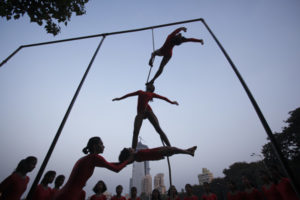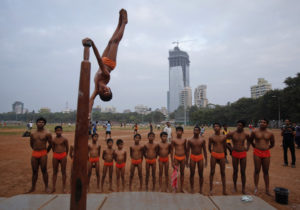As we enter Shivaji Park, located in one of the prime locations of Mumbai and have been famous as the breeding ground of Sachin Tendulkar, we find hundreds of young Sachins and Kamblis and Amres nurturing their cricketing skills. Making our way by them, we reach a corner of the park. We find a group of boys and girls practicing something very ethnic; they are either on a pole or hanging from a rope braided between their toes. This set of young sportsperson is committed towards Mallakhamb, a sport that is very much Indian and one of the hardest in the world.
In 1923, Prahlad Laxman Kale, a master in gymnastics, founded the Samarth Vyayam Mandir. In 1949, he started its office in Shivaji Park with the intention to set up a premium institute of physical education in the heart of Mumbai. As per his mission, Samarth Vyayam Mandir has produced over 1000 national champions in different indigenous sports and still continues to be one of the most preferred institutes for all physical activities, especially Mallakhamb.
Mallakhamb’s history goes back during the regime of Peshwa Baaji Rao II when his fifty-two noted court wrestlers declined a challenge from Ali and Gulab, the two heavy-weight wrestlers from the court of Nizam of Hyderabad. At that time, a teenage boy, Ballambhatdada Deodhar, accepted to fight against them. To ensure his victory, Ballambhatdada went to Nasik for blessings from Goddess Saptasiringi. After 21 days of hard worship, the Goddess was so pleased that she sent Lord Hanuman to his dreams to teach some special tricks of wrestling. Following the orders of Hanuman, Ballambhatdada constructed a wooden plank and practiced. This gave him immense confidence and he returned to Pune for the fight. His first bout was with Ali. He defeated Ali so aggressively that Gulab ran away. After this victory, Ballambhatdada decided to spread this sport to different regions. He named it Mallakhamb where Malla means ‘Wrestler’ and Khamba means ‘Pole’.
Everyday, with the advent of dawn, a sexagenarian, walks into the greens of Shivaji Park and heads straight to his office inside Samarth Vyayam Mandir. Boys and girls, young and old gradually start to gather outside and wait for their Guru to start their practice session. The man comes out, greets his students with the traditional namaste – right hand folded against chest and a light tip-toe movement- and thus the session begins. The man is the legendary master Uday Deshpande who has dedicated 40 years of his life in training and teaching Mallakhamb to his students in Shivaji Park.
“Though it was originated as a complimentary exercise for wrestling, but now Mallakhamb has turned to be a much-needed exercise for all the sports as it helps to develop abilities like strength, stamina, speed, endurance, flexibility, balance, confidence and courage”, says Uday Deshpande. The sport has gone through many testing times, during foreign invasions and British rule. But still it existed, and in many parts of Maharashtra it is a sport that is chosen above others.

“I started Mallakhamb at the age of 7 when my father used to come here for yogas,” says Neeta Tatke, one of the students from Uday Deshpande’s first batch. Those were the days when only boys performed on Pole Mallakhamb that stood around 225cm above ground level. On the other hand, girls practiced on cane. But in due course of time, export-import policies changed and the canes that were imported from Singapore were barely available here. So, the likes of Neeta Tatke had to see the canes being replaced by ropes and thus Rope Mallakhamb came into existence. Another interesting type is Hanging Mallakhamb. This is a shorter version of fixed pole that is suspended with the aids of hooks and chains.
Under the able guidance of Uday Deshpande, Samarth Vyayam Mandir has given several national champions. With the birth of Mallakhamb Federation of India, this sport has extended to other parts of India especially Madhya Pradesh, Gujarat, Tamil Nadu, Kerala and Orissa. But what to be cherished more is that, the Europeans and Americans have taken this ancient Indian sport very seriously. The exchange programmes with foreign nationals often take place in Shivaji Park. Practitioners from here are also invited in countries like Germany and USA to train and teach students there.
“Once when I was in Germany to attend a training programme, I realized how much those people respect our sport, while in our country people are not so much interested in Mallakhamb,” says Aditi Deshpande, a several time national champion who has just retired only to continue as a trainer. As per Aditi, the spread of this sport in India is possible with the initiation of more tournaments. She rightfully says that professionalism only comes when there is more competition and players of Mallakhamb are eagerly waiting for some golden days ahead.

A flashback to an August day in 1936. At the opening ceremony of Berlin Olympics Games, a group of Mallakhamb acrobats carrying India’s independent saffron flag marched two steps behind the official Indian contingent under the Union Jack. At a gala event, those acrobats were given a chance to perform and what the world witnessed was a demonstration of extraordinary skill of grace, speed, agility and balance on a 7 and ½ ft high pole. The spectators were awestruck including Adolf Hitler who later personally presented an honorary Olympic medal to each acrobat. After narrating this incident the sign off message of Uday Deshpande haunts us, “We don’t know when we can again see this day in Olympics, but we all are working very hard to fulfill this dream.”




